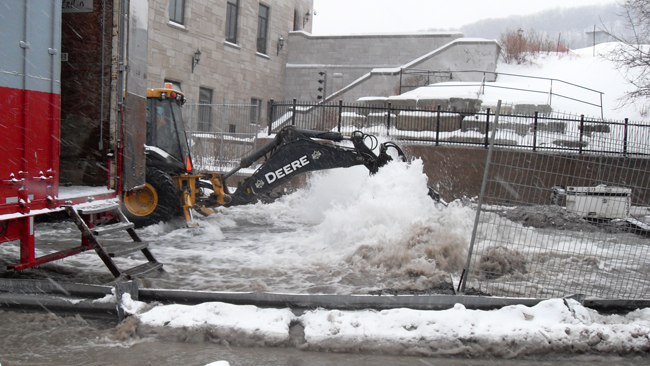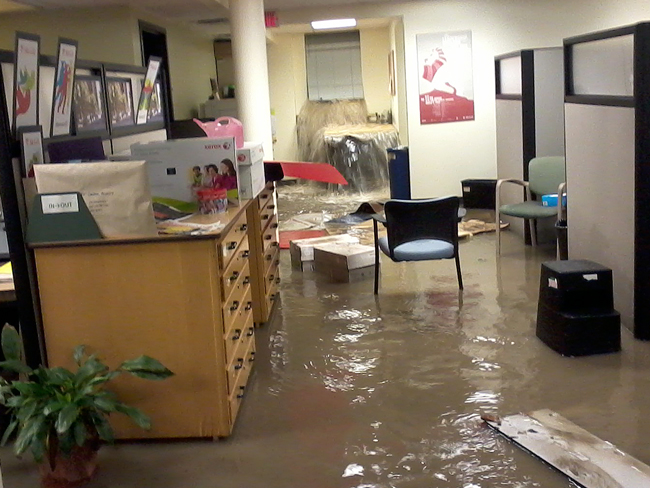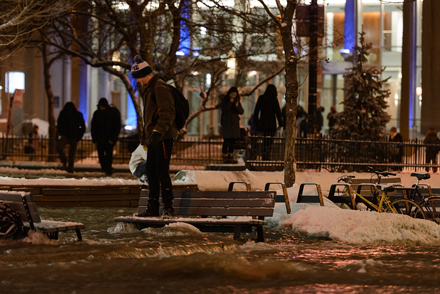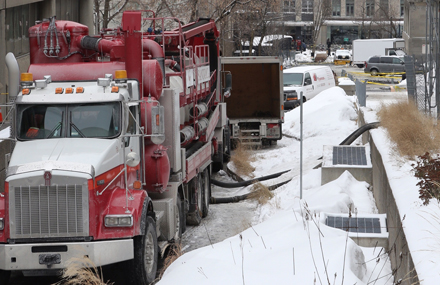
On January 28, 2013, millions of litres of water flowed into the city’s downtown core, flooding numerous McGill buildings
Tony Vaccaro’s office window looks out onto Doctor-Penfield Avenue and the McTavish Reservoir. When water from a 48-inch water main started gushing downhill and onto campus on January 28, 2013, he had a front-row seat.

“It’s a good thing it happened a few minutes before 4 p.m. Twenty minutes later our staff would all have been on their way home,” says Vaccaro, Building Operations Supervisor for the north-east sector of the downtown campus. “The next few hours were the busiest of my 28 years at McGill.”
Vaccaro immediately sent some of his staff to check on the Wong Building and Wilson Hall, which he knew to be among the most vulnerable to flooding.
By 5 p.m., there was already a considerable amount of water in the basement of Wong. Though additional sump pumps were brought in, they could not keep up. “When water started to engulf the transformer, I recommended that we turn off the power, for everyone’s safety.”
That meant evacuating the building, which houses many engineering labs and fragile equipment. It also meant that the sump pumps stopped working.
Streets turn into rivers
Just down the road, the James Administration Building was also heavily hit; the Annex in particular.
“I will always remember looking into the front door of the Annex and seeing water flowing out,” says Hugo Bourcier, part of the Security Services Operations team at the time. The pressure of the water had broken the back window of the small building.

McTavish St. and the road east of the Wong Building had turned into rivers. Security Services quickly had to call in additional agents and deploy them all over campus. “We had to prevent people from coming onto campus and redirect them, or to make sure they would not try to cross McTavish St.,” says Melanie Ouellette, Operations Administrator at the Security Operations Centre at the time. “We even had agents watching the pumps in case they stopped.”
Numerous McGill buildings were flooded, including the basement of the McLennan Library Building, where Service Point and the Welcome Centre are located. At the time, the basement of McLennan also held the McGill Archives and the Rare Books and Special Collections. Building Services staff hurried over to lend a hand to Library staff and try to move as many items as possible.
Cleaning up
Though the City of Montreal managed to reduce the water flow later that evening, water continued to spill into campus for more than a day.
Once the water stopped coming down, the cleanup began. “First, we had to pick up and remove everything the water had carried inside the buildings. Then we went in to clean and disinfect,” says George Lazaris, Director of Buildings and Grounds. “In addition to our own staff and that of our restoration services provider Première action, we had to get crews in from two or three other companies to help out.”

Building Operations (plumbers, electricians), Buildings and Grounds, Campus Public Safety teams were among the many McGill employees who worked around the clock for several days to get the University running normally as quickly as possible.
Remarkably, Service Point and the Welcome Centre were closed only one day. And very few classes were cancelled. “Some of our staff worked 40, 50 consecutive hours. We managed to recover exceptionally quickly,” says Luc Roy, Director of Building Operations, who also credits the efficiency of the class schedulers. “The relocation of classes went very well.”
Most of the James Administration Building, of Wilson Hall and of the Birks Building reopened after two days. In a couple of buildings, it took a little longer for things to get back to normal, from a few weeks to several months, in the case of the James Annex and of Wong. Power in that building was restored temporarily within a few days and permanently a few weeks later. The procedure required extreme caution, to minimize the risks of damaging the transformer or some of the lab equipment. “We had to turn everything back on slowly,” explains Tony Vaccaro.
Vaccaro has seen his share of emergencies at McGill, but this one was the “toughest” one he has ever dealt with. “[Compared to this], the 1998 ice storm was a piece of cake.”
Related story:
Students, prof, team up to battle floodwaters
Makeshift dam built to protect McConnell Engineering from torrent of water

Don’t forget Flood Girl.
#floodgirl, forever in our hearts. float ever downwards amidst cold waters of perseverance you noble soul